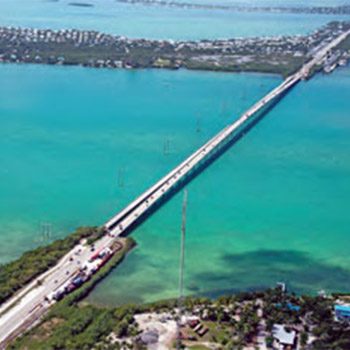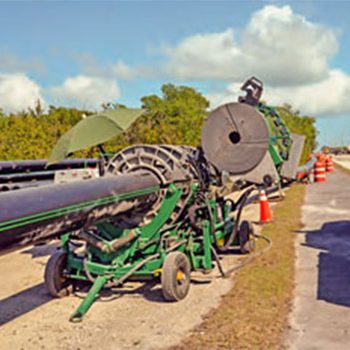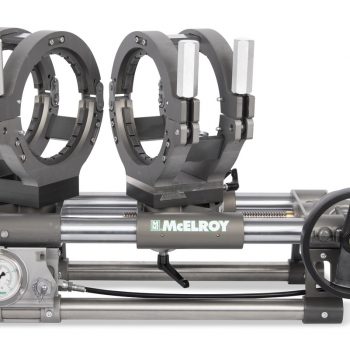The Florida Keys are a 127-mile chain of small islands that bring a unique geography to Monroe County, Fla. So when it comes to providing thousands of residents and millions of tourists with public services across land and sea, you can’t let something as big as an ocean get in your way.
The state of Florida is mandating that a central wastewater system and treatment facility be constructed and completed throughout the Keys by Dec. 31, 2015, to reverse the decline in water quality and deterioration of the coral reefs caused by substandard and outdated sewer systems.
The Florida Keys Aqueduct Authority (FKAA), which provides water services to more than 44,000 customers in the Florida Keys, is currently mitigating the problem along with Monroe County, other municipalities and the state of Florida.
Layne Heavy Civil was awarded the Design-Build contract for the largest segment of the Cudjoe Regional Wastewater Service Area, which includes the Outer Islands Collections and Transmission System for about 5,000 customers on Lower Sugarloaf Key, Ramrod Key, Little Torch Key and Big Pine Key. Layne Christensen Co. is a global water management, construction and drilling company, providing responsible solutions to the world of essential natural resources — water, mineral and energy.
Project Details
The project called for a 17-mile transmission system buried along U.S. 1 and a 5,218-ft pipeline pulled 60 ft under the ocean floor to connect Summerland Key to Ramrod Key. Such a feat couldn’t have been accomplished without the technological advances in horizontal directional drilling (HDD). Layne hired Utility Services Authority (USA) for the job.
It was like working in another part of the world
“The colossal task meant that every aspect of the Design-Build project had to be engineered in order to assure safe delivery of the product piping including calculations to determine loading, product pipe selection and thickness, the need for ballast water to offset buoyancy, tensile strength and conformance to the owner’s end needs,” said USA general manager Chris Lamb. USA is a national utility infrastructure and pipeline contractor specializing in trenchless solutions.
After calculations were done on pipe material and the pipe thickness that would be needed to withstand the depth and pullback force, 18-in. high-density polyethylene (HDPE) DR7 pipe — which was joined together using McElroy’s heat fusion machines — was selected.
The tight setup for the drill was a challenge in itself. It was sandwiched at the entrance and exit points between federally-protected mangroves and the Overseas Highway (U.S. 1) during the height of tourist season, which is the only route into and out of the Keys. Each piece of equipment was placed within a very limited, 35-ft wide and 440-ft long drill pad.
USA dealt with weight restrictions on U.S. 1, daytime exclusions on heavy loads and heavy traffic. The contractor also didn’t have access to specialized equipment within the remote project area.
“It was like working in another part of the world,” Lamb said. “There were literally zero big rig vendors, tool manufacturers or specialized navigators readily available to service us if we experienced an equipment failure. Because of this, we shipped redundant parts and tooling to the project thus eliminating down time and the risk of delaying the job.”
USA used its American Augers 625 as the lead rig. Lamb said it was the right fit for the type of drill rod used and could easily accommodate the forces established in the design calculations. The American Augers DD-210 was used for the intersect drill. The pilot hole intersect was completed in just 17 days.
To ensure accurate line and grade, USA installed a redundant grid wire guidance system to cross-check the accuracy of the steering tools in real-time.
Fusing the Pipe
While this was happening, the nearly mile-long stretch of HDPE pipe was being heat fused and strung into one continuous piece along the narrow U.S. 1 right-of-way by ISCO Industries using McElroy’s MegaMc 1236 butt fusion machine. All together, the project area was about two miles long. McElroy is the leader in the design and manufacture of the industry’s most complete line of fusion equipment for joining thermoplastic pipe such as high-density polyethylene (HDPE), fusible PVC and polypropylene (PP).
“The whole fusion process took a great deal of planning in order to install the necessary ballast line within the 18-in. pipe without hindering the ability to fuse and pre-test the pipe,” Lamb said.
Once the pilot hole was reamed, the 18-in. pipe was pulled in place with 80,000 lbs of force in one 18-hour shift, ahead of schedule.
Safety and protection of the Keys pristine ecosystem and aquatic life were the biggest concerns throughout the project.
“Prior to the start of the project, soil borings were obtained. This information was used to plan out the best vertical route for the drill path in order to mitigate the possibility of inadvertent returns in the waterway,” Lamb said.
The new wastewater project will replace an outdated sewer system in the Keys, which has included cesspits and septic systems in addition to inadequate disposal methods that were not protecting the water and aquatic life that attracts so many people to its shores.
“Reducing nutrient loading to near shore waters expeditiously is important to not only the environment and protection of the reef, but also the Florida Keys tourist-based economy,” said FKAA manager of engineering Tom Walker.



